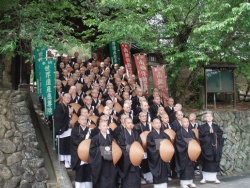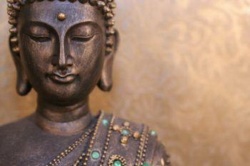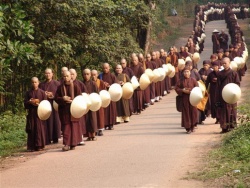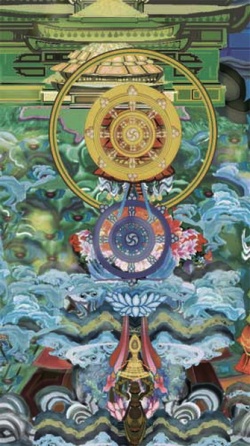Criticisms of Buddhism: Its History, Doctrine and Common Practices
1. The Foundation of Buddhism
1.1. The Literary Foundation of Buddhism, Divisions and Denominations
We know of Buddhism because Buddhist scholars began to write down Buddhist stories during a time when the faith was threatened. This was done after hundreds of years of oral transmission of those stories:
For the first five hundred years the Scriptures were orally transmitted. They were written down only at the beginning of the Christian era, because at that time the decline in faith threatened their continued survival in the memories of the monks. Different schools wrote down different things. [...] The years between A.D. 100 and 400 were the golden age of Buddhist literature.”
"Buddhist Scriptures" by Edward Conze (1959)[1]
Buddhism therefore suffers from the same problems as Christianity and Islam: Everything we know about the religion comes from fallible human sources, and, the earliest collections of writings on the religion have profoundly contradicted each other. The model for oral transmission was, and sometimes still is, followed today, where teachers form long-lasting relationships with students. The founders of major sects are given much credibility and all of this lasts on one big claim: that the teacher passes on the religion as he himself received it. But this model never works. In all instances, Buddhist doctrine and practice vary greatly. Modern-day communities of Buddhists have widely differing practices as a result.
- “Lineages of teachers, which are often reputed to be unbroken right back to the Buddha, pass instructions on practices to their students [... who themselves then] emphasize the need to carry out a practice in accordance with the precise procedure passed from teacher to student. This means there can be striking differences between practices that have been passed on through contrasting lineages. All the practices developed over time, most often in isolation from each other. Consequently, practitioners using contrasting techniques may never have come into contact with each other. There was therefore no need for them to take account of or explain contrasts.”
- Waterhouse (2001) p127
Buddhism suffers from denominational conflicts in the same way as other religions. The scholar of religion Helen Waterhouse notes that "anyone who has had dealings with a range of Buddhist groups will be aware that Buddhists belonging to one group are often happy to criticize Buddhists belonging to another. [...] There is a range of focuses for such criticism, among which perhaps the most common is the questioning of the authenticity of the teachers of other groups in terms of their legitimacy within a lineage or the quality of their personal practice"[2].
Now the advent of globalisation and the internet, disparate Buddhist groups regularly confront each other over differences in doctrine. Waterhouse (2001) states categorically that it is impossible to construct an original form of Buddhism from modern-day examples because the change that has occurred has been too great.
As most major Buddhist sects disagree on some important theological issues, it must be the cast that most of them are wrong in their teachings.
1.2. Nothing New
Not only was Buddhism written down by all-too-human scholars hundreds of years after the events they wrote about, but it seems that the stories themselves were elements of the culture of the time. Just like Christianity, Islam, and all other religions, it was formed from the beliefs of the present culture, a mixture of various trends of the time. The doctrine and feel of Buddhism is very similar to Hindu thought, just with different emphases. It was not a sudden, new, unique revelation. It grew slowly. The teachings of its founder were not written down by the founder himself (same as Christianity and Islam). It shows all the hallmarks of a mythical set of stories, many of them rewrites of older stories. Like most other religions, it seems that any revelations of an otherworldly nature were eerily compatible with what humanity already practised, and already thought.
- “What doctrines, it must now be asked, were special to Buddhism? Not Karma, that was common property which Buddhism shared. Not in asserting that a right mind was superior to sacrifice, that was a primary doctrine of the Jains, and pre-Buddhistic, both within and without the pale of Brahmanism. Not in seeking a way to salvation independently of the Vedas, that had been done by many teachers in various sects. Not in the doctrine that defilement comes not from unclean meats but from evil deeds and words and thoughts; Buddhist writers themselves say that is derived from previous Buddhas. Not in the search for peace through self-control and renunciation; that was the quest of a myriad recluses and all previous Buddhas. Not in the view that there is a higher wisdom than that attained by austerities; that, too, is pre-Buddhistic. Not in the doctrine that non-Brahmans could join an Order and attain religious blessedness; other orders were open to men of low social status and even to slaves. Indeed, the rigid separation of caste was not yet established in the early days of Buddhism.
- The admission of women was not an innovation as it was practiced by the Jains, and even the tradition makes the Buddha accept it reluctantly in the twenty-fifth year of his preaching.”
- "Pagan Christs" by J. M. Robertson
This is quite similar to the situation surrounding the foundings of other world religions.
1.3. The Buddha Was Not a Historical Person
- “The historicity of Buddha is accepted by all. But there is no unanimity of the date. In Sri Lanka, 483 BC is accepted as the date of his nirvana while in Burma 544 BC is accepted. In Tibet it is believed to be 835 BC, while in China, 11th century BC is the accepted date. Buddha was an Indian and the Indian Puranic tradition believes that the nirvana took place in 1793 or 1807 BC.”
- www.hindubooks.org
Stories of "The Buddha" are compiled stories from multiple people and multiple events, canonized and amalgamated. There was no singular "Buddha" as is traditionally taught in Buddhism, and no aspect of Buddhism is other than that you'd expect to find in early India. In short, it is entirely possible that there was no Buddha at all and that the stories of the Buddha's life were merely the same stories of similar lives of other sages, given a new catchy name. Such is the way religions are developed! Some modern Buddhist apologists have acknowledged this and said that Buddhism is the revival of the stories of the last Buddha, thousands of years beforehand, therefore claiming that Buddhism pre-emptively informed Indian beliefs. This is similar to the Christians saying that Satan planted on the Earth many religious beliefs similar to Christianity in the first century, so as to discredit Christianity when it emerged. Such explanations seem to be rather paranoid and rash! The truth is, Buddhism and Christianity were copies of earlier beliefs developed in the same way as other religions developed from culture and history.
2. Western Buddhism is Schizophrenic and Shallow
2.1. The Imbalanced Interest in Selected Rational Texts Only
The form of Buddhism that took root in the west from the 17th to 19th centuries was by necessity completely focused on a small portion of specific Buddhist texts from the Pali canon. The West's idea of Buddhism derived only from this partial view of some texts, divorced from their cultural context. Buddhism was interpreted as an intellectual, rational, philosophical religion based on mental development[3]. This was not a true representation of Buddhism. It is as if a historian stumbles across a particularly legalistic fourth-century Christian treaty, and uses it to form his statements about the entire religion. It was in this context that the first western Buddhist centres were created.
It took hundreds of years before an explosion of texts and material became available that exposed true Buddhist diversity and we have now accumulated a vast knowledge of different scriptures and traditions in Buddhism[4]. Yet what did we do? We continued to study the high-brow stuff that had interested us before. "Within the vast array of textual material, some texts resonate more easily with western ideas of rationality than others. It has often been translations of these texts that receive wide attention while the more esoteric or apparently irrational texts have, until recently, been largely ignored or dismissed"[3]. So what has changed, recently? Read on!
2.2. The Imbalanced Interest in Selected Practises, Devoid of Rationality
After educated westerners embraced an imbalanced and inaccurate form of intellectual Buddhism, concentrating on a few key texts, the general populace took another route. After the New Age swept the west, many individuals made a lifestyle out of 'trying out' religious, magical and otherworldly practices without heeding any of the surrounding religious thinking. Now, the most common form of 'Buddhism' that is practised in the west is the kind done once a week, or perhaps one week a year. Self-help mysticism has found respectability under the banner of 'Buddhism', and presently it is things like meditation classes and weekend (or week-long) retreats that people associate with Buddhism[3]. Nearly all the genuine Buddhist centres in the UK run meditation classes and the like for the general public.
2.3. The Census Exaggerates Buddhist Numbers
"A census is inevitably based on self-definition, and those who identify as Buddhists are likely to include people who live in Buddhist centres or work full-time for a Buddhist organisation or have given up their ordinary lives to become monks or nuns, as well as people who once attended a Buddhist group for a couple of weeks or have learned what they know of Buddhism from books"[3]. In other words, people tend to say on the census and on other impersonal, official forms that they are "Buddhist" simply because they have an interest in Buddhism and/or, they have attended some Buddhist evenings/days, which are actually only a watered-down, disguised form of New Age religious selectivism. Of the 144,453 who put down "Buddhist" on the 2001 Census, I suspect 100,000 are Buddhism-fans, not Buddhists.
2.4. Real Buddhism is Social, not Individualistic
They key problem of the West's approach to Buddhism is that Western religions have become private, individual, voluntary and introspective affairs. So that it how we have approached Buddhism: as individuals reading books, or as individuals seeking enlightenment and peace by doing a little meditation. Buddhism contains much more in the way of superstition, ritual and dogma than we'd like to see, but the worst part is that Buddhism only works as a social system, complete with a mass of lay Buddhists who practice cultural Buddhism. Western Buddhism is simplified, compartmentalized and has its real heart removed. In "The Social Face of Buddhism" by Ken Jones (1989) the author writes that the community (sangha) of Buddhism in the West is completely missing[5]. Since he wrote that in 1989 there have now emerged some unique, small and committed communities of Buddhists in the UK.
Buddhism is simply not suited to specialized cultures where life, work, pleasure, relationships, entertainment, spirituality, are all in different boxes. It is too dogmatically holistic, whereas New Age is the opposite: Dogmatically individualistic. What many Westerners consider Buddhism is merely the more respectable elements of Westernized Indian religion in general, but with an individualistic slant rather than a communal one.
3. Buddhism's Part in War and Strife
Buddhism, of all the major world religions, has the greatest record for peace and morality. Christianity, Islam and other religions' more peaceful elements only come equal to Buddhist movements. War, intolerant killing, torture, ignorance, monopolisation and coercion are hardly present in Buddhist societies. Compared with other powerful religions, Buddhism is saintly in theory and in practice, although other religions such as the Baha'i Faith make a good drive in a similar direction, they are small in size. Nonetheless, various forms of Buddhism in various times have been instruments of war and violence. Buddhist sects have argued and fought over doctrine, over populations and methods, over pride and national independence.
- “Conze has argued [...] that 'some of the success of the [ Tibetan Buddhist ] Gelug-pa [sect] was due to the military support of the Mongols, who, during the seventeenth century, frequently devastated the monasteries of the rival Red sects. The long association of Japanese Zen Buddhism with military prowess and aggressive imperialism has already been noted... [...] and Trevor Ling has argued that South-East Asian Buddhist kingdoms were as militarily aggressive and self-seeking as any others. Walpola Rahula [describes] a war of national independence in Sri Lanka in the second century BC conducted under the slogan 'Not for kingdom, but for Buddhism'”
Buddhism has integrated itself with governments and found itself manipulating the populace just as many other religions have done.
- “After the Meiji Restoration feudalism was replaced by a State dedicated to overseas expansion, and the Zen establishment found a new role in nurturing absolute obedience to it and supporting imperial wars of conquest. In the 1930s Zen Masters occupied themselves more and more with giving military men Zen training [...]. The events of this military epoch in the history of Zen have been chronicled by Ichikawa Hakugen, a Zen priest and professor at Kyoto's Hanazono University, who in books like The War Responsibility of Buddhists, condemned Zen's (and his own) collaboration with Japanese fascism.”
Buddhism in Japan and the USA has seen the emergence of "training" for corporate employees designed to quell dissatisfaction and discord, in short, of covering up the symptoms of illness and bad practice rather than tackling the problems of social malaise and industry work standards. Buddhism, despite its highly socially-centered morality frequently slips into individual remedies when in order to be consistent and true to its own teachings it should be engaging in wider social work.
4. Nirvana and Reality
4.1. The First Cause Dilemma: A Fundamental Contradiction
Ultimate transcendental reality is nirvana, and a prerequisite of achieving it is the complete abolition of the self. But the same dilemma faces Buddhists as faces theists such as Christians and Muslims: Why is it that there are any beings at all that are not in this perfect state?
- In Christianity and Islam, why did God create evil? If God is all-loving and all-powerful, why doesn't it just put everyone in Heaven?
- In Buddhism, why is there a false reality at all? If there is no self, by what mechanism do "drops" of the ocean come to think of themselves as being individual?
A common defence is that it is somehow better if little bits of consciousness are deluded for a while, or that they have to suffer in the real world, before returning to Heaven or Nirvana. But if Nirvana and Heaven are perfect, why is it that anything needs to be done to improve on that state? The questions have remained unanswered by Christians and Buddhists for thousands of years. It seems that there is no logical reason, no theological reason, no rationality, behind this belief other than to say that it is connected with the Human fear of death but actually has no basis in reality.
4.2. World Rejection
The concept that all of our desires and attachments to the world are the things holding us back, and that reality is an illusion that we shouldn't engage with, is a disastrous and potentially harmful doctrine when encouraged in some individuals. Although Buddhism teaches a "middle-way" inbetween complete asceticism and world-acceptance, it seems that the common-sense approach of renouncing Buddhism and merely striving to be a good person is more logical.
- “During the whole of [The Buddha's) ministry, however, he embraced a world-renouncing life which excluded sexual contact. The rules for the Buddhist monks reflect this example of the Buddha. Such rules are still applied in Theravada Buddhism, but married monks are found among Mahayana Buddhists.”
- "The Phenomenon Of Religion: A Thematic Approach"
- Moojan Momen (1999) [ Book Review][8]
4.3. Buddhist Psychology is Too Idealistic
You can spot Buddhist psycho-babble from quite a while off, there is a distinctive feel and look about Buddhist therapists and self-development. The truth is that Buddhist psychology is like Communist ideology or Christian guilt methodology: It only suits a particular type of person. Buddhist practices are not a universal solution to social ills or spiritual problems, but a certain type of solution catering for only certain types of person.
For a religion that makes universalist claims about the enlightenment of all beings, it is stuck with a mythology about Indian, Chinese and Eastern-style sages, teachers and students; when it is only a certain portion of humanity that can exist in those roles. The rest do not fit into the Buddhist mould, and Buddhist advice and counsel is counterproductive.
Ken Jones notes the real dangers that Buddhist ego training presents to certain types of people, producing neurotics and psychotics at worst, and mental imbalance at best. He notes the difficulty of adapting traditional Buddhist methods to swathes of society who do not conform to the model of the ego that Buddhist psychology requires of students.
Buddhism unfortunately, for a religion with so much social potential, falls over its own dogma and mythology when it comes to individual, personal development of people in general. It operates best as a peace movement, as a mediator, as an intelligent social commenter rather than a personal religion.
Those who do take earnestly and naturally to the methods of Buddhist self-development are those who are already more developed and already more intelligent Humans. Lower Buddhism, of the masses, is dumbed-down and mostly useless as a unique tool, functioning as a smotherer just like popular religions do in all countries. Higher Buddhism caters for those who are already on a higher level, just like scholarly Christianity suits the intelligent and elitist Satanism suits the naturally strong and mature, Buddhism doesn't offer much insight into how the masses may improve themselves beyond offering the same social programs that socially aware governments offer.
5. Negative Social Effects
5.1. The Inequality of Women
The religious hierarchy in Buddhism is typically male-dominated, as it is in most traditional religions. Moojan Momen writes: "Even in Buddhism, where Buddha himself gave permission for the setting up of an order of nuns, the Buddhist scriptures represent him as having been very reluctant to do so [...three times] saying, 'If women go forth under the rule of the Dharma, this Dharma will not be long-enduring.' He said that it would be like a blight descending upon a field of sugar cane. Eventually he relented, however, and allowed an order of nuns. However, the nuns were to remain subordinate to the monks in all ways"[9].
Nuns in Tibetan lineages of Buddhism can never be more than 'novices' because there is no ordination process for them; and female Therevada Buddhists cannot become ordained either because the lineage required died out and has not been revived due to opposition from male-dominated Buddhist authorities[10].
Lama Choedak Rinpoche explains a little of the current situation in an article celebrating his organising of an ordination event for female Buddhists in Australia:
- “The controversy surrounding female ordination is not a problem restricted only to Christianity. Even though ordination of women in Buddhism occurred during the life of the Buddha, his initial reluctance to ordain women seems to have been misinterpreted by many people. This misinterpretation has left a legacy of doubt and indecision among the orthodox Buddhist leaders. Some Buddhist countries did not even introduce the Bhikhuni ordination while others who did could not sustain the lineage for long. The Bhikhuni ordination was never introduced to Tibet even though there are hundreds of nunneries there. Theravadin tradition lost the lineage that they once had and initiatives to revive the tradition in Thailand have faced stiff opposition from the mainstream Buddhist leadership.
- Tibetan Buddhists proudly claim that theirs is the complete form of Buddhism, but it would be hard to maintain this if Bhikhuni ordination is not established. It is said that in order to say that there is Dharma in a land there should be Sangha consisting of four members, including fully ordained Bhikhunis. Whatever are the reasons, there are miserably few female teachers in Tibetan Buddhism and a few seem to be in that position because of the merit of there being sisters or daughters of well known male teachers. Nunneries do not have qualified female teachers and even countries, which have a Bhikhuni ordination system, are reluctant to have female Buddhist teachers.”
- "The First Bhikhuni Ordination in Australia" (2007)[11]
Some authors such as Rita Gross, are positive about the relationship between Buddhism and women. She says that "a reconstructed authentic core of Buddhism reflects and supports feminist values, in so far as it is 'without gender bias, ..., and that sexist practices are in actual contradiction with the essential core teachings of the tradition'"[12]. Given the actual historical relationship, how can she hold to this view? Well, she adds two caveats. Firstly, presumably when she says "core teachings" she defines it in a way that removes social teachings, and secondly the caveat in the middle of her statement (replaced by an ellipsis, above) adds: "whatever the practical record may reveal". Unfortunately, even if Buddhist philosophy was gender-neutral, it is only the practical side that has any meaning! There is no difference between being denied equality and standing by someone who backs it up with a proper understanding of their own religion, and, being subjugated by someone who backs it up with an improper understanding of their own religion. Either way, the religion's teachings ought to state gender equality, especially as no text has been written in times when misogyny and patriarchy have not been infamous. Nonetheless Rita Gross's position is further undermined "when she starts generalizing that all religions were originally non-patriarchal until they were subverted by men" (Hawthorn 2011), and other historians have criticized her approach as "unhistorical".
5.2. Sex Scandals and Cover-ups: the Same as Other Religions
Like other religions, Buddhism suffers from the same impulse to hide events that tarnish the reputation of Buddhism. Note the similar trends in these examples:
- For example, Lama Choedak Rinpoche, who we quoted from above regarding female ordination, runs the Tibetan Buddhist Society of Canberra, Australia. He has been embroiled in a sex scandal after it emerged that he had had affairs with several women from Canberra's Tibetan Buddhist Community in 2010. His initial responses and the reactions of Buddhist officialdom were revealing. When complaints about his behaviour first emerged within the group, he and senior Buddhists 'said talking to the media or telling new group members what had happened could be spiritually damaging and prevent other Canberrans from achieving enlightenment through buddhism' - in other words, they told the complainers not to speak about the incidents[13].
- Sangharakshita founded the Triratna Buddhist Community, known until 2010 as FWBO (Friends of the Western Buddhist Order), one of the UK's largest Buddhist groups and perhaps the most well-known. But he only founded this order after being dismissed in 1966 from the English Sangha Trust due to concerns over his personal behaviour, including his receiving accusations of sexual misconduct. But that wasn't all. The "FWBO Files" almost prides itself on the wealth of problems surrounding Sangharakshita's sexual life even before 1966:
- “He returned to England in 1964, having been, reportedly, expelled by the Indian authorities. According to this report, considerable concern had built up over rumours about Sangharakshita's sexual behavior with young male students of Buddhism. In particular, there was an Indian family that wished to prosecute Sangharakshita for having seduced their son. A very senior Indian politician, who was sympathetic to Buddhism and also something of an anglophile, intervened personally in order to protect the good name of Buddhism from the risk of being damaged by the publicity surrounding such a case. He persuaded the family to drop the case, on condition Sangharakshita left India. A post as resident monk at the Hampstead Buddhist Vihara in London was arranged for Sangharakshita. Christmas Humphreys, a prominent English Buddhist of the time, was closely involved in arranging this move, but he omitted to tell the Hampstead Buddhist Vihara of the full reasons behind the move, and he also took great care to keep the politician's name out of things, lest this politician be accused of colluding in a cover-up.”
Both of these instances reveal multiple people at high-levels "looking out" for Buddhism by suppressing the revealing of cases of sexual misbehaviour among the founder - not even mere laypeople - of major Buddhist movements. As these are the people who are scrutinized most widely, it stands without doubt that these represent only a small portion of the complete picture, and that many more cover-ups have remained in shadow.
More reading:
- In "The Peacock vs. the Ostrich - Religious Behaviour and Sexuality" by Vexen Crabtree (2008) I conclude that the teachings of traditional religions, steeped in most cases in patriarchal dominance and sometimes in doctrines of celibacy, are the cause of so much sexuality-based strife.
5.3. Human Suffering: Paying the Price for the Sins of a Previous Life
There is a lot of suffering in the world. This fact leads Buddhists to look to Buddha for an answer, and leads Christians to look to Christ for an answer. Both claim that ultimately a blissful state can be attained with no suffering: that eventually everything will be alright. The psychological attraction of such beliefs is one of the greatest factors behind the success of religions that explain away suffering.
But, Christianity and Buddhism have both dehumanized suffering in history and have both led people to accept suffering when they should not. In Christianity, especially historically and within conservative Christianity, suffering is a test from God, a result of the sins of us and our ancestors. In Buddhism, suffering is the status-quo of life and in popular Buddhism a person suffers now for their transgressions in previous lives. Both Christianity and Buddhism explain away present evil as an unavoidable circumstance that we are better to accept than to combat.
- “The poor, the powerless and the diseased are therefore assumed to owe their misfortune to moral transgressions in past lives, no matter how virtuously they may strive to improve their condition in this life. This mystification is applied also to whole peoples and nations. [...] "This retributive view of kamma is quite alien to canonical Buddhism, as Buddhist scholars and teachers have made clear on many occasions.”
The result is a depressive acceptance of social ills, taken as they are to be endured rather than cured. Anti-progressionist, such views have led the world into its darkest years. As with Christianity, when popular Buddhism informs, for example, a painfully disabled person that their present torture is a result of their own past actions or sins, the result is a harmful negativity and horrifies any compassionate person that such doctrines ever came to be. Karmic resolution and Christian sin are both harmful concepts with negative effects on society, especially on the weak and unfortunate.
5.4. The Social Vampirism of Monasteries
Buddhism monasteries in the UK, like many monks, cannot support themselves, and require donations from the (working) community around them. Traditionally, laypeople would (they believed) improve their karma by giving to monasteries. This system is very similar to Christianity, and has the same problem: It is merely a form of unsustainable vampirism whereby non-producers and world-rejectionists are encouraged in their mystical beliefs, by guilty laypeople who want to feel good about themselves. In reality, it is the non-producers who should feel guilty!
6. Conclusions
Buddhism is a wonderful religion socially, participating as a principle player in all forms of global peace & stability movements, very environmentally aware and an intelligent force for good in world politics. Historically it has contributed much less inhumanity to the world than have all other religions of similar stature. But its greatness is limited by its own dogma and mythology, its psychology is too idealistic and assumptive and its self-development aspects are too specific. In the West Buddhism has become no more than the respectable elements of New Age, merely called "Buddhism" and missing all of its main elements, replacing them with commercialist and popularist gimmicks. The London Buddhist Society and other high-brow Buddhist institutions in the West are inactive, elitist gatherings of intelligent pseudo-Buddhists, genuine Buddhists in the West are very hard to find.
The history of Buddhism is problematic. It has grown from the cultural practices and beliefs from particular parts of the East and there seems to be no evidence for Buddhist beliefs. Not only that, but the Buddha himself lacks any evidence for his existence, apart from the fact that many varied and contradictory stories were once passed on orally for hundreds of years before being written down. It is impossible to separate fact from fable.
Buddhist traditions all claim that through a long and accurate teacher-student lineage, their practices were those ordained by the Buddha. Yet major divisions exist between the branches of Buddhism as to what practices are good, what are bad, and what the beliefs of the religion are. It is clear that with so many contradictory claims, most Buddhists must therefore be wrong in their beliefs.
In an age where the UN and many secular multinational organisations have more strength and much willpower, social Buddhism has passed its hey-day as a useful tool of humanitarianism and global welfare. Buddhist groups could be replaced with secular organisations with little real change in mentality.
Overly mystical and too idealistic about human nature, only the world-wide social elements of Buddhism have genuine merit, the rest is yet-another self-fulfilling religion of superstition, assumptions and pseudopsychology.
Footnotes
- ↑ Conze (1959) p12.
- ↑ Waterhouse (2001) p150.
- ↑ 3.0 3.1 3.2 3.3 Waterhouse (2001) p122-127.
- ↑ Baumann (2001) p296-7;304;307
- ↑ Jones (1989) p275-6
- ↑ Jones (1989) p285-286.
- ↑ Jones (1989) p212.
- ↑ Momen (1999) p446.
- ↑ Momen (1999) p439-440.
- ↑ Waterhouse (2001) p139.
- ↑ On www.buddhanet.net (2007), accessed 2011 May 25.
- ↑ Hawthorne (2011) p144. See Rita Gross's Buddhism after Patriarchy: A Feminist History, Analysis and Reconstruction of Buddhism (1993) p210, published by State University of New York Press, Albany, NY, USA. Added to this page on 2013 Apr 05.
- ↑ buddhistchannel.tv news website accessed 2011 May 25.
- ↑ The FWBO Files on ex-cult.org accessed 2011 May 25.
- ↑ Jones (1989) p66.
References
Baumann, M
(2001) Westward Dharma: Buddhism Beyond Asia (ed.) Berkeley, California: California Press, chapter 5. In "From Sacred Text to Internet" by Gwilym Beckerlegge (2001).
Beckerlegge, Gwilym
From Sacred Text to Internet (2001, Ed.). Ashgate Publishing Ltd, Aldershot, UK, in association with The Open University, Milton Keynes, UK. This was a course book for the OU module "Religion Today: Traditional, Modernity and Change" which ran until 2011.
Clarke, Peter B.. Peter B. Clarke: Professor Emeritus of the History and Sociology of Religion, King's College, University of London, and currently Professor in the Faculty of Theology, University of Oxford, UK.
The Oxford Handbook of The Sociology of Religion (2011). Published by Oxford University Press, Oxford, UK. First published 2009.
Conze, Edward
Buddhist Scriptures (1959). Published by Penguin Books.
Hawthorne, S�an. Hawthorn is Lecturer in Critical Theory and the Study of Religions and Chair of the Centre of Gender and Religions Research at the School of Oriental and African Studies, University of London, UK.
Religion and Gender (2011). This essay is chapter 7 of "The Oxford Handbook of The Sociology of Religion" by Peter B. Clarke (2011).
Jones, Ken
The Social Face of Buddhism (1989). Published by Wisdom Publications, London, UK.
Momen, Moojan
The Phenomenon Of Religion: A Thematic Approach (1999). Published by Oneworld Publications, Oxford, UK. [Book Review]
Robertson, J M
Pagan Christs.
Waterhouse, Helen
Department of Religious Studies at the Open University, chapter 3 "Representing western Buddhism: a United Kingdom Focus" in "From Sacred Text to Internet" by Gwilym Beckerlegge (2001).
Source
By Vexen Crabtree 2011 May 25
humanreligions.info
















